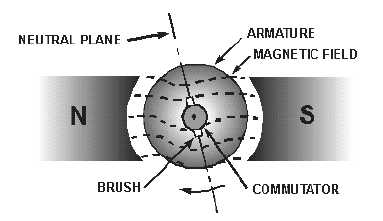2-10
In a series motor, the rheostat speed control may be connected either in parallel or in series with the
armature windings. In either case, moving the rheostat in a direction that lowers the voltage across the
armature lowers the current through the armature and slows the motor. Moving the rheostat in a direction
that increases the voltage and current through the armature increases motor speed.
Q13. What is the effect on motor speed if the field current is increased?
ARMATURE REACTION
You will remember that the subject of armature reaction was covered in the previous chapter on dc
generators. The reasons for armature reaction and the methods of compensating for its effects are
basically the same for dc motors as for dc generators.
Figure 2-9 reiterates for you the distorting effect that the armature field has on the flux between the
pole pieces. Notice, however, that the effect has shifted the neutral plane backward, against the direction
of rotation. This is different from a dc generator, where the neutral plane shifted forward in the direction
of rotation.
Figure 2-9.—Armature reaction.
As before, the brushes must be shifted to the new neutral plane. As shown in figure 2-9, the shift is
counterclockwise. Again, the proper location is reached when there is no sparking from the brushes.
Q14. Armature reaction in a dc motor causes a shift of the neutral plane in which direction?
Compensating windings and interpoles, two more "old" subjects, cancel armature reaction in dc
motors. Shifting brushes reduces sparking, but it also makes the field less effective. Canceling armature
reaction eliminates the need to shift brushes in the first place.
Compensating windings and interpoles are as important in motors as they are in generators.
Compensating windings are relatively expensive; therefore, most large dc motors depend on interpoles to
correct armature reaction. Compensating windings are the same in motors as they are in generators.
Interpoles, however, are slightly different. The difference is that in a generator the interpole has the same
polarity as the main pole AHEAD of it in the direction of rotation. In a motor the interpole has the same
polarity as the main pole FOLLOWING it.

